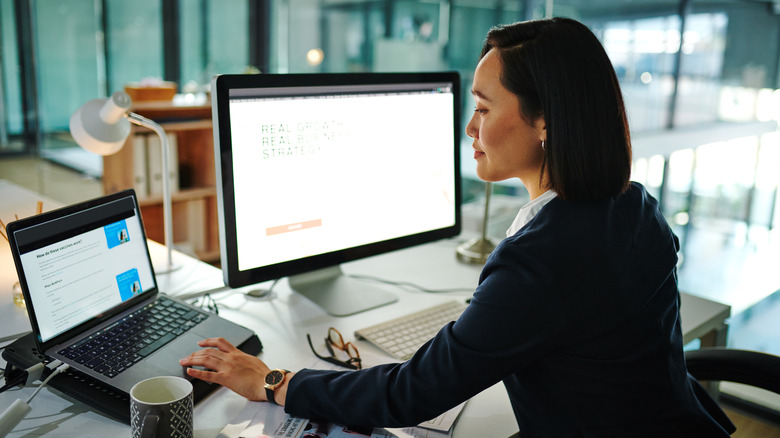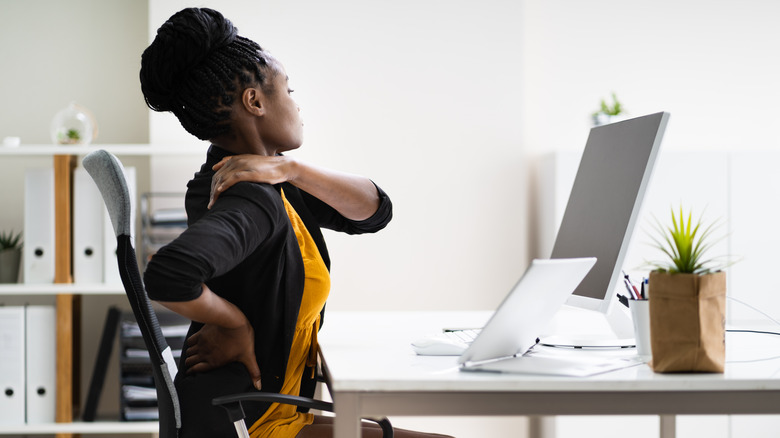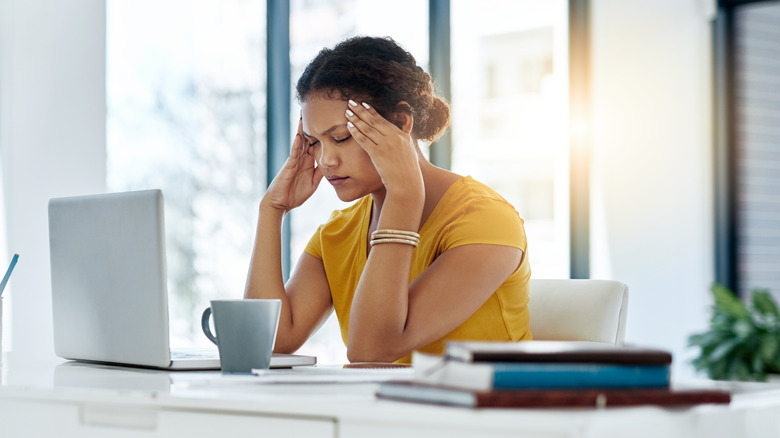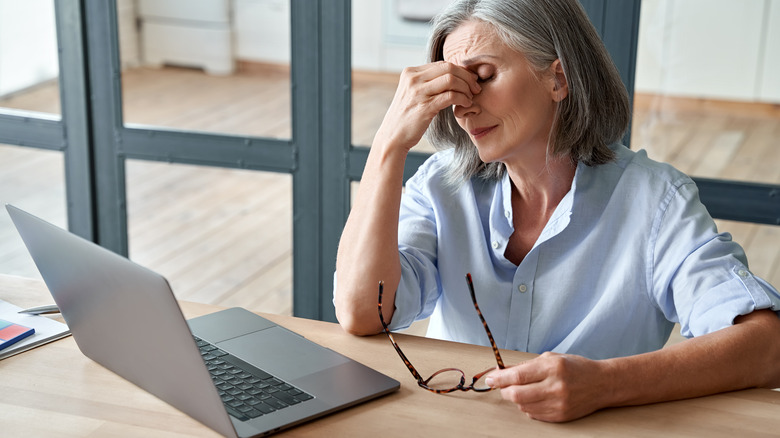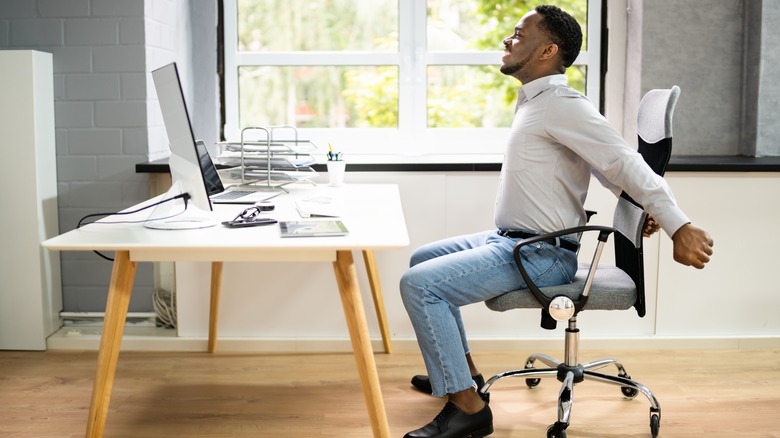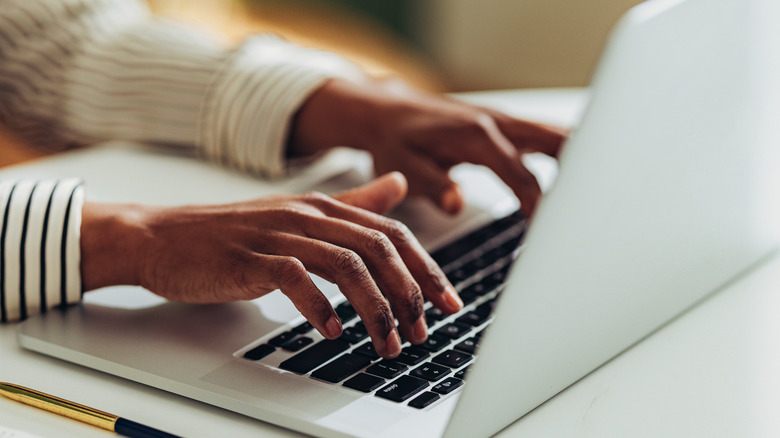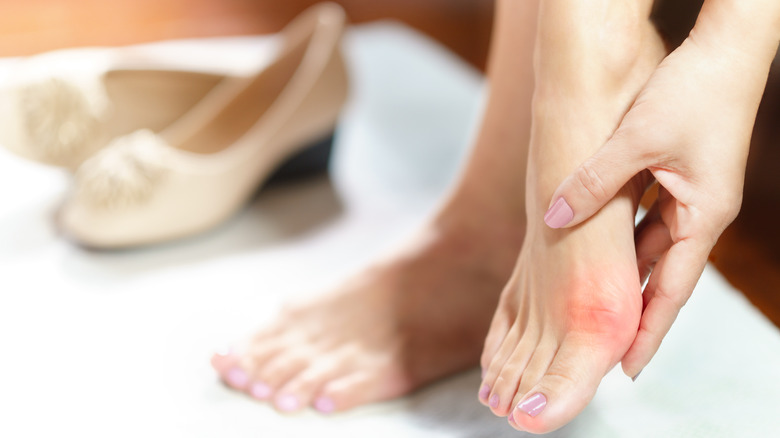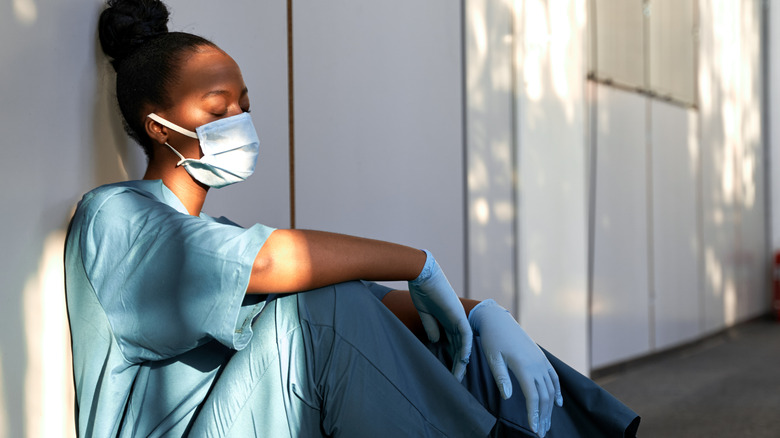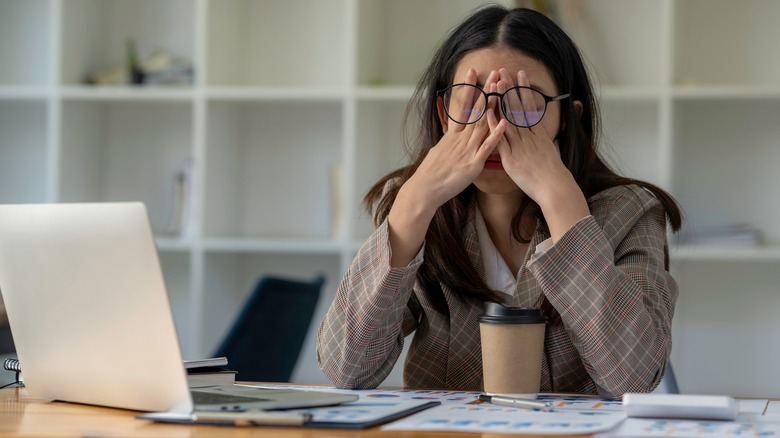We've Got The Fixes For Your Worst Work-Day Ailments (Yeah, Our Eyes Are Strained Too)
For most of us, work is a necessity. We have bills to pay, and if we're not punching a clock, there won't be any food on the table. However, work causes wear and tear on our bodies. Even if your work lets you sit all day, there are unhealthy ramifications. Standing all day isn't any easier, either. If work has you sitting for the majority of your shift, your job is contributing to a higher risk of heart disease, and possibly even cancer. There are things you can do during the workday to lower these risks, and depending on what you're doing while seated for work, you could be straining your neck and eyes, exhibiting bad posture that leads to all sorts of soreness, and more.
Then again, standing all day can leave you with an abundance of aches and pains as well. Whether you're standing in one place all day or moving around the entire time you're on the clock, pains may begin to stack up on you, leaving you wanting to do nothing more than sit when you get home. Plus, standing all day isn't good for your heart health either.
When work is a pain, we have some tips to help you feel less strain and battle those workday ailments.
Neck pain
Working at a computer can be a real pain in the neck, literally. If you're not practicing good posture or investing in an ergonomic chair, you're likely feeling the pain daily, whether it's mid-shift or at by end of the day. We tend to hunch over our computers, typing away, researching, or filling out forms. After a few eight-hour shifts like this, you'll surely find yourself ending the day with stiffness and pain. Luckily, there are a few things you can do to help, aside from the aforementioned posture correction.
One of the best ways to help get that strain out of your neck is to take a moment out to stretch it. Tilt your head to the left, place your left hand on the right side of your head, then pull and stretch the muscle. Then, do the opposite side. You can also take your chin with your left hand and pull toward your left shoulder, as if you were trying to reach your shoulder with your chin, but do it gently. Repeat on the other side. These exercises can help loosen tight neck muscles. In a discussion with SELF, Dr. Erich Anderer, chief of neurosurgery at NYU Langone Hospital–Brooklyn, said doing some neck stretches during your workday can "... actually be very preventative for developing tech neck."
Back pain
Along with neck pain, back pain is also pretty common when it comes to desk jobs. From the upper back to the lower back, you may find yourself wishing that you had an office masseuse. According to UCLA Health, the first step in lessening your back pain when you work sitting all day is to be sure you're sitting right— that means measuring your desk and chair, and evening the eye level of your computer. Again, an ergonomic chair can come in handy, as it will help you sit with better posture. You can also buy cushions for your current office chair if you're not in the market to invest in a new one. If it's lower back pain near your tailbone, get a pillow made to help alleviate pressure on your coccyx bone.
Much like with your neck, stretching can help when it comes to fighting back pain at the office. Stand up and do some side bends when you feel any pain or tightness coming on. It can also help to take a break once in a while where you can get up and walk around for 15 minutes or so.
Headaches
There's nothing more annoying than having to spend part of your workday battling a headache. But for some of us, work headaches are a common thing. There are many underlying factors when it comes to this type of ailment, from not getting enough sleep, to having too much eye strain, and even bad posture (the same thing hurting your neck and back). We'll talk about eye strain more soon, but let's talk about those headaches directly caused by work — stress headaches.
We think stress at work is the most common cause of headaches, and aside from eliminating the stressor, you pretty much just need to take care of yourself. If it's co-workers stressing you out, find ways to better deal with them. If it's a particular project, muster through to the next one that may be less stressful. Be sure to stay hydrated, don't skip the caffeine if it's something your body is used to, and eat a healthy diet (skipping meals at work can aid in head pain). If your workday headaches are coming from an allergen, like someone's cologne, talk to the person about wearing a little less, and be sure to have some headache relief in your desk (peppermint oil is a great natural headache reliever).
Eye strain
Now let's talk about that eye strain. If you spend a good deal of your workday staring at a computer screen, you've probably experienced at least some eye strain, which can lead to headaches. While you can take something for your headache, if you don't deal with the eye strain, it'll come right back. Our biggest suggestion when it comes to dealing with eye pain from your computer is to take breaks whenever you can. Spending some time away from your computer can alleviate the initial pain of eye strain. Your eyes will enjoy the break.
Of course, if you're working at a computer every day and eye strain is seriously causing you pain, you may want to see your eye doctor. It could be more than just your computer causing you issues — you may need glasses or a new eyeglass prescription. You can also invest in anti-reflection coatings on your glasses to cut down on the glare from the computer screen, and blue light filters to help protect your eyes. If you don't need glasses or you usually wear contacts, you can invest in eyeglasses with plano lenses (no prescription) with special coatings to help you protect your eye health.
Stiff joints
Along with pains, your joints may be getting stiff while you're sitting all day for work. You don't need to have any previous joint issues, like arthritis, to suffer from this type of pain. It stems from spending most of your day in a chair. Of course, joint pain is also common for people who stand or walk all day for work. How you battle your joint pain will partially revolve around what's causing it — whether it's from sitting or from standing too much. Either way, stretching is important.
For both standing and sitting jobs, taking some time to stretch your muscles and joints out — like you would before or after a workout — can also help. You can use the same stretches for your neck and back, as well as give your upper and lower back a stretch. While standing, reach up into the air. Then, bend at the waist to try to touch your toes. Repeat a few times. If you sit for most of the day, the best thing you can do for your joints is to get up a couple times an hour and move around, even if you simply walk around your desk three or four times. If your day is spent mostly on your feet, you definitely want to take some sit-down breaks. Be sure that you're properly lifting (with your knees, not your back), and opt for comfy shoes with arch support.
Finger pain
If you work with your hands, whether you're typing, running a machine, or whittling wood, there's a chance you end your workday with some finger pain. If you have hobbies that use your hands too, you may need to cut down on those during the workweek so you can give your fingers a bit of a break. There's a chance your finger pain could be caused by arthritis, and if not, there's a chance your overuse of your hands could lead to this issue in the future, or possibly worse.
When your fingers are aching mid-shift, take a break. Stretch your fingers out, ball up your fists tight, then stretch them again. Try to loosen up those stiff digits. At the end of your workday, there are some other things you can do to help ease the pain of sore phalanges. You can try using pain relieving creams, or icing your fingers, but only for about 20 minutes at a time. Be sure to remove rings if you're wearing any, as sore hands sometimes swell and the pressure from your jewelry can add more pain.
Wrist pain
If your finger pain comes with stiffness, this could be a sign of something worse than simple finger strain. If you find that pain shoots from your fingers into your wrist, you experience numbness in your hands, or you have wrist pain along with your finger issues, you may be developing carpal tunnel syndrome. Weakness in your hands and fingers is another possible sign of carpal tunnel and comes along with the random dropping of things because of that weakness.
If you spend a lot of time typing on a computer, there are things you can do to help prevent carpal tunnel before it becomes a problem. An ergonomic mouse, mousepad, and keyboard are great items to have on hand to be sure you're not adding more pressure on your wrist during work than need be. Give yourself a break from typing at least once an hour. When you do feel the pain coming on, take a break that includes icing your wrist for about 20 minutes. You may also want to invest in a wrist brace made to help those with wrist pain and carpal tunnel syndrome — even if you don't have that problem yet, it may help in the prevention of it.
Foot pain
Standing or walking all day can be hard on your feet, and this is especially so if you're wearing the wrong shoes. But even the best shoes can still leave you longing to sit down. Start by looking for shoes with good arch support, and be sure that they fit comfortably. If they're too loose, you may get blisters, and if they're too tight, you'll have extra toe pain from them being scrunched up all day. While the right shoes help, too much time on your feet can still cause pain — and we have some suggestions on what to do about it.
Start your workday with some stretches. Again, standing and walking all day for work is just like a workout, so stretching will help. Sit down and flex your feet some — they need stretching too. When you're back home after a long day, ease foot pain by icing them and putting them up. We also suggest a nice warm foot bath with some soothing Epsom salts. A foot bath is great for relieving aches and giving tired feet a nice break, and toss in some lavender oil to help relax your mind, too.
Knee pain
Knee pain is the worst and can make it difficult to do your job. For some of us, knee pain is something that strikes even when we're sitting for the day. For those walking or standing, knee pain can be crippling if it's not dealt with promptly. So, what causes knee pain at work, and what can you do about it?
Knee pain can come from strain on your tendons, it can come from injuries, and it can also be a sign of arthritis. If you walk or stand a lot for work, you may be adding pain to your knees because of the floors you're standing on (cement floors may cause more pain than carpeted floors). Wear comfortable shoes, like those suggested for keeping your feet pain-free. If you stand in place on cement or other hard floors, invest in a cushioned mat you can stand on. Your weight plays a factor here as well. If you kneel a lot for work, you could be injuring your knees. Kneel on a cushioned surface for some added protection. If your knees hurt while sitting, it could be arthritis, or perhaps your chair is up too high or too low. To ease the ache, adjust your chair. If you have knee pain regularly, talk to your doctor. You can also wear a brace, and ice your knee with it elevated after work.
Mental fatigue
It seems like the workday just started and you're already exhausted. Or, you had an exceptionally rough customer and now that their issue is fixed, you feel like you need a nap. It's difficult to stay focused on your tasks, and you simply feel drained. You're likely suffering from mental fatigue — happens to the best of us. It may seem unavoidable, and sometimes it is, but there are things you can do to pull yourself out of that slump. You definitely want to do something about it, though. If you don't, your fatigue could grow into something more. Next stop: burnout.
A few ways to energize your brain again include decluttering your workspace, setting small goals for yourself without letting procrastination get the best of you, and not taking on too much at once. All of these things add to the stress you feel while at work and can quickly lead down a path of fatigue. Don't be too hard on yourself when you don't meet goals, and if you're not meeting them often, set smaller, more digestible ones. You can always add more to the list if you get everything done early. When brain drain strikes, take a break. Go for a short walk, take five minutes to meditate and clear your mind, get hydrated, and come back to your workspace with a positive perspective.
Burnout
When mental fatigue strikes and you let it take control, all of the stress at work builds up to a breaking point, and this can lead to burnout. Burnout can make you crazy — so crazy you may think about quitting your job altogether. Before you make any rash moves, let's look a little closer at this phenomenon, and how you can get past it without needing to look for a new employer.
Work stress, when left unchecked, can lead to an increased risk of heart disease. Stress is also a common factor in weight gain, because of that pesky hormone cortisol. Stress also debilitates your immune system, which can make you more susceptible to things like the common cold. It's the increased stress on top of illness, on top of still needing to get the job done, that makes us burn out. Some signs of job burnout include irritability, sleepless nights, dissatisfaction overall, difficulty staying focused, as well as illnesses like stomach aches and headaches. If you suspect you're experiencing job burnout, you can do something about it. Take some time off, if you can. This will give you a chance to evaluate whether you want to continue this job or not. At work, don't bite off more than you can chew with projects. Know what's expected of you, and work to ease over any issues with other people in your workforce. You can also practice mindfulness techniques at work, like breathing exercises and meditation.
